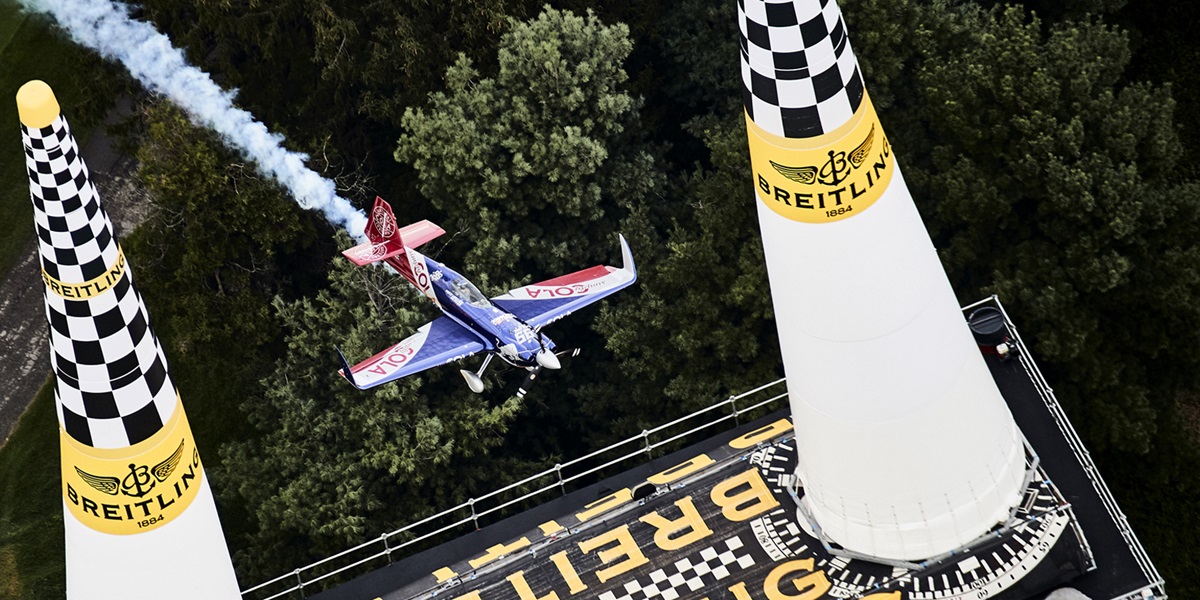
Red Bull Air Race Pilots Prepare for Different Course Types Just Like IndyCar Drivers
October 05, 2017 | By Paul Kelly, Indianapolis Motor Speedway
Drivers in the Verizon IndyCar Series display the most diverse skills in global circuit auto racing, tackling short ovals, superspeedways, natural road courses and street circuits during the season.
It’s no different for pilots in the Red Bull Air Race World Championship.
While Verizon IndyCar Series venues are grouped into four categories, Red Bull Air Race World Championship pilots fly on circuits constructed over land and water during their season. And much like in the Verizon IndyCar Series, each type of track poses unique challenges and rewards.
The Red Bull Air Race World Championship season finale is set for Oct. 14-15 at the Indianapolis Motor Speedway, one of two “land tracks” on the eight-venue schedule in 2017. The other track based over solid ground is at another motor racing facility, Lausitzring in Germany, which hosted the penultimate round of the series Sept. 16-17.
Red Bull Air Race pilots competed over water, ranging from ocean bays to rivers, during the first six races of the season: Abu Dhabi, United Arab Emirates; San Diego; Chiba, Japan; Budapest, Hungary; Kazan, Russia, and Porto, Portugal.
“There are differences,” two-time Red Bull Air Race Master Class World Champion Kirby Chambliss said. “Over water, sometimes your depth perception is not as good, especially if you’re turning away from where you can’t see the gates. It’s got its own set of problems.”
Fourteen Master Class and six Challenger Class pilots will fly on a course above the IMS oval infield. Planes race against the clock at low altitude while exceeding 200 mph and encountering forces of up to 10 G’s, navigating a low-level slalom track marked by 82-foot-high, air-filled pylons called Air Gates.
Pilots turn as quickly and efficiently as possible without pulling more than 10G’s in the vertical turn maneuver before flying toward the next gate. Penalties are assessed for hitting the Air Gates, for speed and altitude violations or for not flying in the proper formation through certain Air Gates. The quickest pilot against the clock in each round wins.
While every circuit in the championship includes a variety of single and double Air Gates to test pilots, water-based courses also have a random, natural element that doesn’t exist at land-based circuits, Chambliss said.
“Over the land, what’s nice is that the gates don’t move as much,” he said. “Imagine the gates out in the water: They’re basically on a barge. The tide goes in; the tide goes out. So you can change that a few degrees, and that makes a big difference for us. On the land, it won’t do that.”
There are variations within certain types of tracks in IndyCar racing. For example, Mid-Ohio and Road America are both natural-terrain road courses, but Mid-Ohio’s shorter, tighter layout is considered more technical than the fast, flowing circuit at Road America.
Again, it’s no different in the Red Bull Air Race World Championship.
IMS is considered a more challenging, technical track because it’s confined within the facility’s infield, Chambliss said. That places a premium on a pilot’s ability to turn and maneuver more quickly than at some more open, water-based circuits. That’s just fine with Texas native Chambliss, who lives in Tucson, Arizona.
“Since we’re so contained in the Speedway, it will make it a little more of a technical track, which I tend to prefer,” Chambliss said. “So I’m looking forward to it.”
There’s another aspect to racing at IMS that excites Kevin Coleman, the only American pilot in the Challenger Class, which prepares pilots for racing in the elite Master Class much like Indy Lights grooms drivers for the Verizon IndyCar Series. IMS and Lausitzring are the only circuits with a runway adjacent to the racetrack, and Coleman said IMS is the only track in which the runway is beneath the middle of the course.
At other circuits, Coleman said pilots dive into the circuit from a takeoff point outside the facility or area hosting the race. The unique position of the runway at IMS creates a fun challenge for pilots and great viewing opportunities for fans, Coleman said.
“The cool thing about the IMS track is that it’s a standing start for us,” Coleman said. “We take off right in the middle of the track. It’s all about who can get the airplane going faster.
“It’s a unique thing. It’s the only time we get to do that this year. We’ll be right there in the track in IMS, taking off and landing right in front of everybody.”
Coleman also enjoys flying near the fixed objects at IMS. That’s quite a change from the open spaces of water-based courses and even the infield at Lausitzring, which doesn’t feature a large structure like the Panasonic Pagoda or IMS Museum or clusters of trees like at IMS.
“Most of the time it’s easier to fly over water because there’s usually nothing out in the water,” Coleman said. “It’s just open space. The cool thing about IMS is we’re flying over the trees and buildings. Everything is still there. Light poles and everything.
“It takes a little more concentration because visually you’ll see stuff going by. You’ll see trees go by. We’re only 50 feet over the ground at 200 mph pulling 10 G’s. That’s what’s really fun about IMS, is having the visual cues and seeing the trees and everything else go right by.”
World champions in both classes will be crowned at IMS from a field featuring pilots from all over the world, including Americans Chambliss, Michael Goulian and Coleman. Two-time series world champion Chambliss is fourth in the tight Master Class standings with 52 points, 11 behind leader Martin Sonka of the Czech Republic.
Visit IMS.com to buy tickets or for more information on the Red Bull Air Race World Championship.